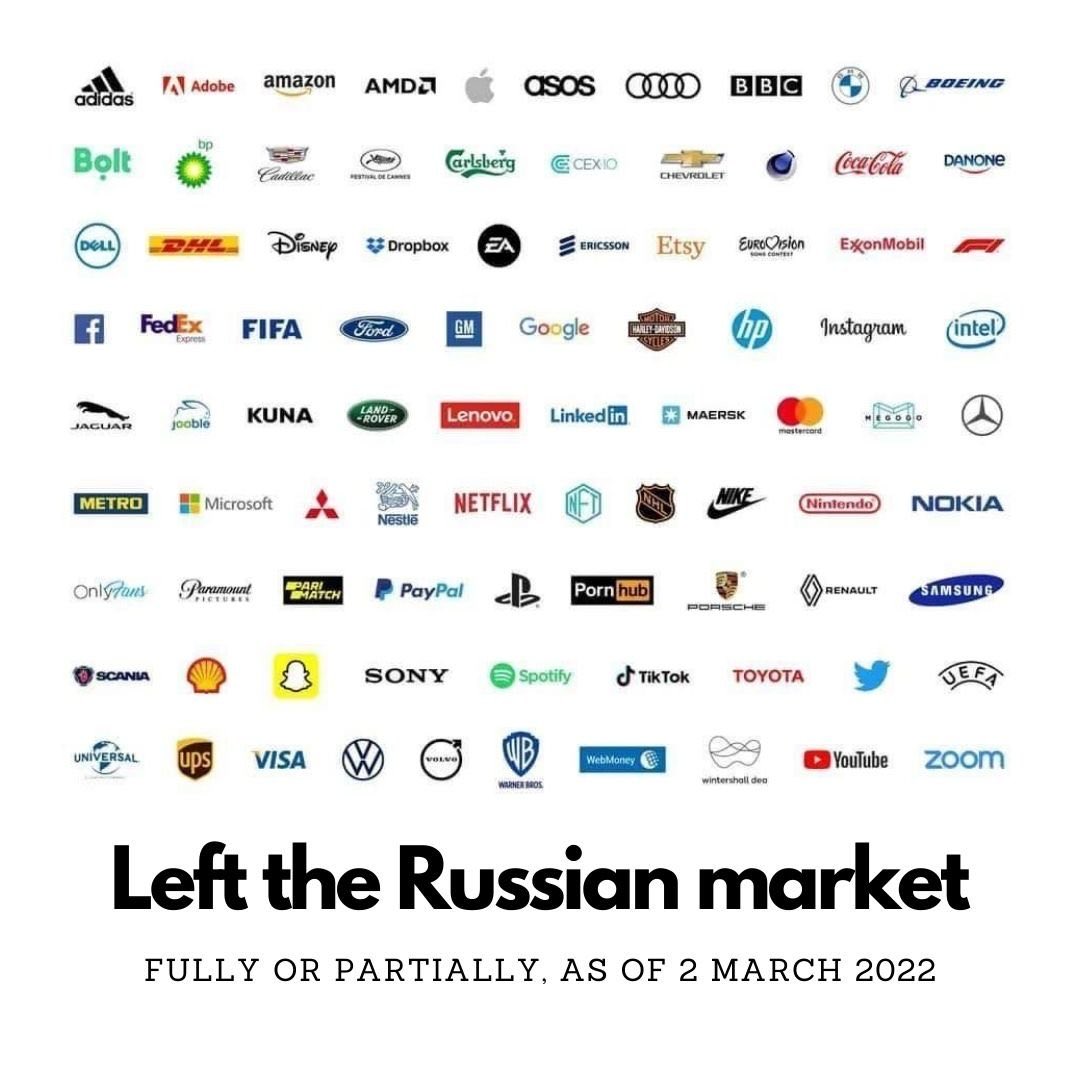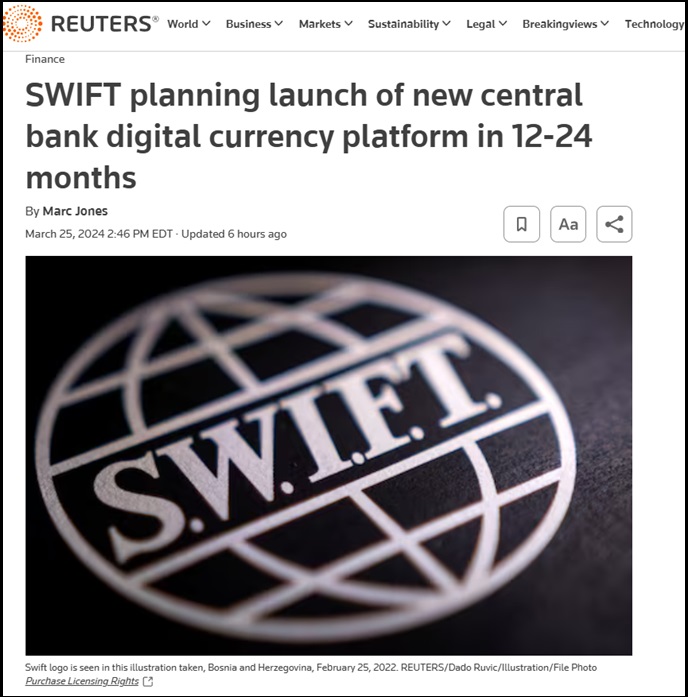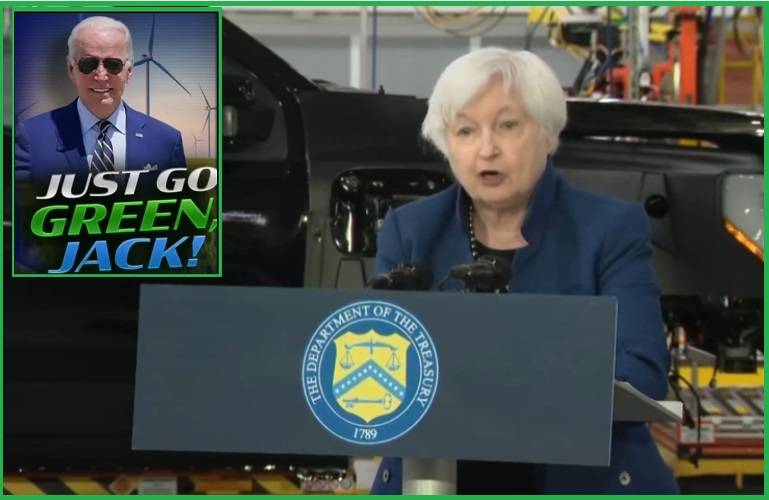An Ask Me Anything thread is soon to follow. Here’s the context:
I never expected to travel the world of a dollar-based central bank digital currency implementation. Two years ago, I was surprised by the construct of the Western sanctions against Russia; however, my curiosity was driven more by the outcome of the intended economic isolation, and not necessarily about the granular construct of the sanctions themselves.
What surprised me initially, was the conversation that never took place in the financial sector. For the first time in history the U.S Dollar was being used as a weapon, not only against Russia, but against any Western corporation who did not comply with the demands of the U.S government. I began highlighting the issue MARCH 5, 2022.
The sanctions against Russia were unlike any set of sanctions that came before. The financial sanctions against Iran, Cuba, North Korea and Venezuela all stood as examples of prior economic sanction constructs, but the financial sanctions against Russia were different. The SWIFT exchange was shut down, Western trade into Russia was halted, and private Western corporations were forced to divest themselves of assets held within Russia.
Under the guise of “economically isolating Russia”, the sanction regime was driven by the U.S. Treasury, U.S. State Dept., and fully supported by Western allies in Europe, Canada, Japan, Australia and New Zealand. Each of the aforementioned nations followed the exact same path.
Given the history of the prior decade,where Russia enlarged its footprint of influence, the sanction regime just did not make sense. It was obvious that non-Western nations would continue trading with Russia, and most of those same non-Western nations were trading with the USA. My simple question was, “won’t alternate countries just step in to fill the void of trade eliminated by the sanctions?”
If, for example, India is still buying widgets from the Western zone, wouldn’t an enterprising Indian company just start buying extra widgets from the USA, Canada or Europe and then begin brokering a portion of those products into Russia? It seemed like common sense, and indeed that type of exchange is exactly what happened.
On the ground, in Russia, there are now Western stores missing, but the Western products are still available under different Russian flagship names. Starbucks closed, and now as you can see from above, it’s Stars Coffee. Same coffee, tables, chairs, cups, and even employees, just a different name. Starbucks, and every other Western company was forced to divest, sell assets at fire sale prices, and exit the market.
All the following companies did the same.
 Despite all the parent companies leaving, their retail products are still available through a system of brokered buying and distribution. Third-party companies simply stepped in to fill the void. You can still buy the newest Samsung TVs and Apple iPhones in Russia, but now they come with a slightly higher price, as the broker adds their markup.
Despite all the parent companies leaving, their retail products are still available through a system of brokered buying and distribution. Third-party companies simply stepped in to fill the void. You can still buy the newest Samsung TVs and Apple iPhones in Russia, but now they come with a slightly higher price, as the broker adds their markup.
On the financial side, the inability to work in dollars or Euros was initially a problem, but workarounds were fast to surface {SEE HERE}.
What I soon realized, in my research, was that essentially nothing changed for the ordinary people within Russia, other than some “branded items” were no longer available. Factually, most Russian people didn’t care, and a large percentage are oblivious to the sanction issue. The sentiment of nationalism or national pride actually increased; they rallied around their leadership.
Two years later, the economy is doing well, Russia is selling energy to nations who have a need, trade is taking place in non-dollar denominations, and the impact is, well, really not much.
However, once you realize the sanctions never had any material impact, then the question is why it was so important to weaponize the dollar-based trade currency? Surely other nations would now look at their dollar dependency as a potential risk because they too could become a target if the USG made that arbitrary decision.
That’s exactly what happened, and is a big part of the non-Western zone drive to join the antifragile BRICS+ trade alliance.
So, with all these downsides, why did the U.S. do these specific sanctions this way?
When I dug deep into this issue, I realized the financial walls were not created to keep Russia out of the financial system; the walls were erected in the Western zone to keep the dollar-based system locked-in.
ME: …”The same way the Patriot Act was not designed to stop terrorism but rather to create a domestic surveillance system. So too were the “Russian Sanctions” not designed to sanction Russia, but rather to create the financial control system that will lead to a USA digital currency. The Western sanctions created a financial wall around the USA (dollar-based west), not to keep Russia out, but to keep us in. The Western sanction regime, the financial mechanisms they created and authorized, created the control gate that leads to a U.S. digital currency.” (more)
 LARRY FINK in 2022 – NEW YORK, March 24 (Reuters) – BlackRock Inc’s (BLK.N) chief executive, Larry Fink, said on Thursday that the Russia-Ukraine war could end up accelerating digital currencies as a tool to settle international transactions, as the conflict upends the globalization drive of the last three decades.
LARRY FINK in 2022 – NEW YORK, March 24 (Reuters) – BlackRock Inc’s (BLK.N) chief executive, Larry Fink, said on Thursday that the Russia-Ukraine war could end up accelerating digital currencies as a tool to settle international transactions, as the conflict upends the globalization drive of the last three decades.
In a letter to the shareholders of the world’s largest asset manager, Fink said the war will push countries to reassess currency dependencies, and that BlackRock was studying digital currencies and stablecoins due to increased client interest.
“A global digital payment system, thoughtfully designed, can enhance the settlement of international transactions while reducing the risk of money laundering and corruption”, he said.
[…] In the letter on Thursday, the chairman and CEO of the $10 trillion asset manager said the Russia-Ukraine crisis had put an end to the globalization forces at work over the past 30 years.
[…] “While companies’ and consumers’ balance sheets are strong today, giving them more of a cushion to weather these difficulties, a large-scale reorientation of supply chains will inherently be inflationary,” said Fink.
He said central banks were dealing with a dilemma they had not faced in decades, having to choose between living with high inflation or slowing economic activity to contain price pressures. (read more)
 (Reuters) – Global bank messaging network SWIFT is planning a new platform in the next one to two years to connect the wave of central bank digital currencies now in development to the existing finance system, it has told Reuters.
(Reuters) – Global bank messaging network SWIFT is planning a new platform in the next one to two years to connect the wave of central bank digital currencies now in development to the existing finance system, it has told Reuters.
The move, which would be one of the most significant yet for the nascent CBDC ecosystem given SWIFT’s key role in global banking, is likely to be fine-tuned to when the first major ones are launched.
Around 90% of the world’s central banks are now exploring digital versions of their currencies. Most don’t want to be left behind by bitcoin and other cryptocurrencies, but are grappling with technological complexities.
SWIFT’s head of innovation, Nick Kerigan, said its latest trial, which took 6 months and involved a 38-member group of central banks, commercial banks and settlement platforms, had been one of the largest global collaborations on CBDCs and “tokenised” assets to date.
“We are looking at a roadmap to productize (launch as a product) in the next 12-24 months,” Kerigan said in an interview. “It’s moving out of experimental stage towards something that is becoming a reality.”
Although the timeframe could still shift if major economy CBDC launches get delayed, getting out the blocks for when they do would be a major boost for maintaining SWIFT’s incumbent dominance in the bank-to-bank plumbing network.
[…] A raft of heavyweight commercial banks including HSBC, Citibank, Deutsche Bank, Societe Generale, Standard Chartered and the CLS FX settlement platform all took part too, as did at least two banks from China.
The idea is that once the interlink solution is scaled-up, banks would have one main global connection point able to handle digital asset payments, rather than thousands if they were to set up an individual one with every counterparty. (read more)
ALSO In 2022 – [White House] – President Biden often summarizes his vision for America in one word: Possibilities. A “digital dollar” may seem far-fetched, but modern technology could make it a real possibility.
 A United States central bank digital currency (CBDC) would be a digital form of the U.S. dollar. While the U.S. has not yet decided whether it will pursue a CBDC, the U.S. has been closely examining the implications of, and options for, issuing a CBDC. If the U.S. pursued a CBDC, there could be many possible benefits, such as facilitating efficient and low-cost transactions, fostering greater access to the financial system, boosting economic growth, and supporting the continued centrality of the U.S. within the international financial system. However, a U.S. CBDC could also introduce a variety of risks, as it might affect everything ranging from the stability of the financial system to the protection of sensitive data.
A United States central bank digital currency (CBDC) would be a digital form of the U.S. dollar. While the U.S. has not yet decided whether it will pursue a CBDC, the U.S. has been closely examining the implications of, and options for, issuing a CBDC. If the U.S. pursued a CBDC, there could be many possible benefits, such as facilitating efficient and low-cost transactions, fostering greater access to the financial system, boosting economic growth, and supporting the continued centrality of the U.S. within the international financial system. However, a U.S. CBDC could also introduce a variety of risks, as it might affect everything ranging from the stability of the financial system to the protection of sensitive data.
Notably, these benefits and risks might vary significantly based on how the CBDC system is designed and deployed. That is why Executive Order 14067, Ensuring Responsible Development of Digital Assets, placed the highest urgency on research and development efforts into the potential design and deployment options of a U.S. CBDC. The Executive Order directed the Office of Science and Technology Policy (OSTP), in consultation with other Federal departments and agencies, to submit to the President a technical evaluation for a potential U.S. CBDC system.
Today, OSTP is publishing its report, Technical Evaluation for a U.S. Central Bank Digital Currency System, which lays out policy objectives for a potential U.S. CBDC system and analyzes key technical design choices for a U.S. CBDC system. The report also estimates the technical feasibility of building a CBDC minimum viable product and describes how a U.S. CBDC system might affect Federal operations. The report makes recommendations on how to prepare the Federal Government for a U.S. CBDC system. Importantly, the report does not make any assessments or recommendations about whether the U.S. should pursue a CBDC, nor does it make any decisions regarding particular design choices for a potential U.S. CBDC system. (read more)
A digital dollar creates a unique id attached to that digital dollar. Ultimately, the central bank that issues the digital dollar controls what the digital id can do (that’s you), and what those digital dollars can be used for (what you can do).
Digital dollars can be blocked from gun purchases, and digital ids can be used to stop unapproved users from purchasing guns – or a gas guzzling suv, or a house that’s too big, or the non-compliant fridge, or whatever.
Sellers of goods (or information) can have their ids banned from receiving digital dollars, just as VISA and MasterCard blocked sellers of guns from accessing their electronic transaction system. With digital dollars, “demonetization”, an alarmingly familiar modern term, can become a function of a financial regulation system. “Debanking” another alarmingly familiar term, also becomes much easier.
Ultimately, a dollar-based US-Central Bank Digital Currency, ie a “digital dollar,” is about control.
Every transaction has a unique digital fingerprint, and every digital dollar can be traced by the IRS to the digital id associated with it.
There is a BIG difference between electronic funds (current), and a digital dollar (future).


For a global cleaving to happen, the Eurodollar system needs to collapse first. But that means every country on earth collapses economically with it, but the US falls last. This is what you need to understand. There is no replacement, there is no de-dollarization without de-leveraging, which means destroying their economies to do so. No politician could survive that kind of turmoil. But Europe will provide the US nothing, since we are intentionally de-industrializing them with what’s going on currently; we will be stuck with Canada and Mexico as a regional trade bloc. This is how it’s going to be. Why? We don’t have trade deals with individual European countries, the EU will splinter, and they will be right mad at us with no recourse since they’re scrapping their industrial base as we speak.
And the new governments of Europe will toward Russia, unless they become a Klaus Schwab bug eating dictatorships.
Central bank digital currency
Corrupt bank digital control
Some observe:
CBDC is apparently one of multiple hobbling and control mechanisms being built into the US Bloc as part of bringing it down to the planned end state.
Adding to the others: ESG, Energy/EVs, DIE, LGBT, biotyranny, police/surveillance state.
All based on grotesquely exaggerated imperatives: Safety, security, environmental, social justice, public health.
While the primary sinking mechanism continues: US Federal debt.
One pretext for US CBDC will be integration with the other CBDC systems globally. That’s why the other systems lead.
It’s all one big movement, one big global shift.
What is the coming end state? The trends point to a future convergence: US Bloc sunk to weak totalitarian vassals under a “multi-polar global governance” with the unannounced seat of power in the East.
It all comes down to scientific prowess and industry – the US lost dominance, the East built it, the rest is “managing the decline” of the US Bloc now.
Pray for our children, as the US is moving toward neo-feudalism and totalitarianism in its coming lowered position.
As the WEF claim in their 2030 video: You will own nothing. You will eat bugs. The US will no longer be a super power. Which means total economic collapse. If this comes to fruition, we will become helpless, injected, and barcoded livestock. This is worse than Orwell could have ever imagined. These people are power hungry, rapaciously greedy, inbred billionaire psychopaths. What makes them so dangerous is their wealth and positions in society.
So, as Sundance likes to say, “Live your best life” while you can because it’s going to be a rough ride.
Maybe of interest.
I still don’t know why our kids in the Military haven’t stopped this bogus regime.
What, exactly, would you like them to do?
The CIA has been instigating a color revolutions against any country who goes against the US $ reserve currency and the petrol $ they have doing this for 40+ years .Arab Spring example Russia today todays example…Nothing new here its business as usual..
Now you know why Blackrock is now involved in crypto. I am in small on crypto but the writing is on the wall its the only way to beat the new system that I can see.. I am involved in 6 different positions so far this is not investment advice just my opinion..
He is risen! Happy Easter treepers. I try to do all of my shopping locally and when practical in cash. With the cost of goods so high it remains impractical to carry more than a couple hundred as that amount is consumed rather quickly in my local Kroger subsidiary. Hence, the bulk of our transactions are already digital. Which means the govmint knows my purchasing habits and my day to day activities. Is that not already a digital coin transaction based on the US dollar?
No, it is not remotely the same. Sundance has made accurate comparisons in layman’s terms in recent days. Scroll back in older posts and check it out.
I can’t help but think about all those shipping containers full of $100 bills that haven’t been laundered yet. Is the CBDC a method to bring them into the financial world? I am very suspicious of new systems that offer no apparent improvement to the lives of the common man.
If we are moved to the digital dollar, how is that going to fly with the millions of illegals who are flooding our country, and who mainly deal only in cash money. Even illegals who have been here for years, don’t deal with banks. They are a cash only sector of society. And a very large and growing sector at that. How is Larry Fink and his minions going to wrangle these folks in and put them on the digital dollar?
Suspect they will develop their own alternate, internal currency.
The enemy is real. He serves his father, Satan. Christ came to destroy Satan and death. We were baptized into His death, buried with Him, risen with Him. Death has no power over us. May we do to our enemy as he wished towards us. Hurrah America!
The Militia.
A self formed, self governing army composed of self armed citizens between 16 and 60, mostly male but female also.
Their Purpose.
To guard against and prevent, by deadly force if necessary, the usurption of the personal freedoms of their citizenship and the Republic form of government that guarantees those freedoms.
Their Demise.
As God’s blessings increased upon America, Americans became derelict in guarding the foundational freedoms, morals, premises, and laws that produced those blessings. In doing so they allowed a government army, the National Guard, to replace their own citizen army, which we shall call the Citizen’s Militia. Concurrently, the government was stealthily and steadily infiltrated by domestic enemies of the Constitution and America; with the purpose to disembowel America from the inside out until the entire Republic falls dead to the ground.
Their Future.
In grave doubt. The current federal and most state governments have passed laws outlawing military training that ‘seeks to overthrow’ the government, as those states define government. Claiming one is training to protect America from foreign hostiles may or may not prevent federal or state charges being lodged.
The Expediency.
Should 2024 be stolen as 2020, the Republic has irrevocably fallen and will not arise except The People arise and reclaim that which is rightfully theirs, the Citizen’s Militia.
Western world Bolsheviks test out their freedom-suffocating ideas on Australia and Sweden first, then UK, and Canada.
Since the populous in those countries is essentially subdued into complacency, their try-outs work, and then with small modifications, they apply to the next set of countries, eventually reaching US.
I am sure they understand that locking out a bunch of resource-rich countries from the ‘reserve currency ecosystem’ will cause those countries to build out their own ecosystem.
Western world had US-dollar and the law-of-contract court system that enforced the law of contract. Those two made the US-dollar-based systems very attractive to any company be in Russia or Brasil.
Today, however, the BRICS countries are technically ready to replace the US dollar for trading, all the technology (thanks to crypto), already exists.
They have 2 problems however:
a) their new currency has to be backed up by a mineral resource. And they have to chose which one it it is.
b) they do not have a judicial system that can enforce the law-of-contract. Because their judicial systems are deeply corrupt.
(a) is very easy to solve, (b) goes into the heart of their problems.
If they solve (b), the US-based world economy will simply collapse in about 10 years.
US borrowing cost will skyrocket.
This will cause unstoppable inflation in US, that will end up with consequences we could only imagine
There is another solution to (b). Simply wait a bit for the US judicial system to become completely corrupt. It is on that trajectory now.
Is there any room to hope this scenario will not play out?
The idea of creating funds to spend out of digital transactions has never made sense to me. If people don’t see the value of a currency, they won’t use that currency because they can’t give up real property in exchange for a currency that is, in truth, worthless. A return to the bartering of only real property in exchange for real property would happen. If this is not allowed, the economy will will be foisted on its own petard and we will lose our property rights along with all of our other rights as the Government tries to collect real property to back their contrived economy. Maybe the Government should be doing feel good seminars about the contents of Adam Smith’s “The Wealth of Nations”. Digital currency will change the world all right! I just don’t see how anything good would be accomplished.
Evidently the russian market is more honest than the american market is right now !!!!!!
I understand very well that CBDC is a way to control the population, but I cannot quite see the big picture yet. Hopefully with a little more studying, things will come into focus. My question is, do you have any insight into what this does to our debt; how it will impact the Federal Reserve and their control of the money supply; and whether this CRDC will devalue our currency?
You have inspired me to look at this closer and try to understand it in a big picture way. Thank you for that.